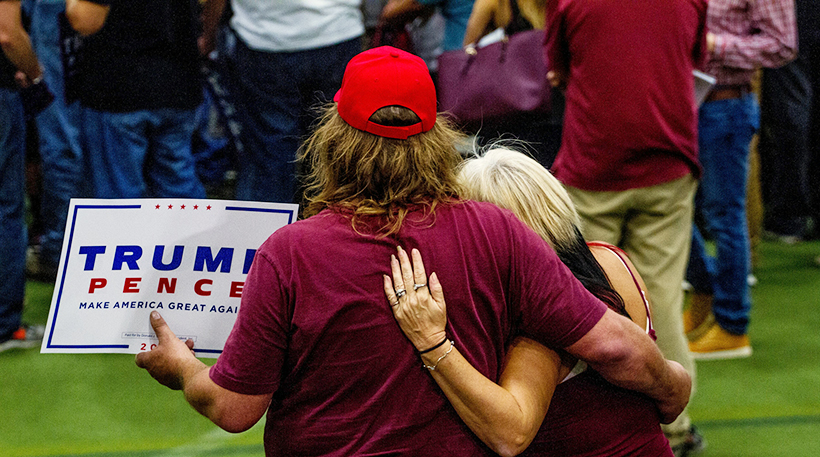
In 1897, a psychologist named George Stratton put on a pair of goggles that flipped everything 180 degrees: up became down, left became right. He wore them for eight days, initially stumbling about in severe disorientation. Eventually, however, his brain adapted to the new way of seeing–and he was just as disoriented when he took them off. For historian of science Thomas Kuhn, Stratton’s experiment illustrated that there is no such thing as “seeing the world as it is.” We see the world through the lens of ideas handed down to us.
And sometimes those lenses change. The old ideas don’t let us see what we need to see or do what we need to do. We lost big on Tuesday, and we’ve now only begun the work of analyzing what went wrong. Part of that work involves moving beyond criticizing what people did, or didn’t do, and taking a sharp look at the lenses that allowed so many to get this thing so wrong.
We habitually think of politics through the directional metaphor of left, center, and right. Political positions are arranged on a spectrum along which people are presumed to move as their views change: a rightward shift, a leftward movement.
In our two-party system, parties are assigned positions on the spectrum: Democrats on the left and Republicans on the right. Undecided voters are assigned to the middle, under the presumption that someone who shifts between the two parties must be a political moderate, equally allergic to a strong progressive platform and to the reactionary ranting of the conservatives.
The left/right divide as currently understood may obscure more than it reveals.
Finally, in national elections, this party-dominated spectrum coalesces into a face-off of two candidates for the presidency, as if all of political life could be boiled down to a slugfest between two individuals once every four years.
At best, this vision is simplistic. At worst, this way of categorizing the political life of our country furthers the divisive agenda of capital. In fact, we have to accept some of Trump’s supporters may have had a hard time bringing themselves to vote for him, just as some on the left had a hard time bringing themselves to vote for Hillary Clinton.
Just before the elections, we spoke with a woman whose big issue was health care. She was annoyed because her clinic was forcing her to come in to be seen to get refills on her medication. She didn’t fundamentally mind coming to the doctor, but every time she came she had to pay $250. I asked her about health insurance, but this was the payment with her plan. She had purchased insurance through the marketplace because it was required. She paid $200 a month for the plan and she had a $6000 deductible which essentially meant all her health care costs were out of pocket anyway. As we talked about the changes under ACA she hoped for a time when it wouldn’t exist anymore. I didn’t ask specifically if she was planning on voting for Trump for president, but I’m sure she was, as most people did in the rural part of Pennsylvania where I live.
Did this woman vote for Trump because she supported his racist, sexist, homophobic, xenophobic rhetoric? No. I don’t think she was heading to any Black Lives Matter protests (yet), but bigotry was not what motivated her. She voted for Trump because she, like most Americans, are suffering economically and she saw an opportunity, through the election of Trump, to make a concrete improvement in her own financial situation.
Other conversations were similar. A waitress at a local diner told us that, as a woman raising daughters, she’d like to vote for Hillary, but her husband worked in manufacturing and she was afraid of more plants being closed and jobs being sent overseas. One of our relatives said that she was voting for Hillary despite disagreeing with her on reproductive choice. She wasn’t excited, she said, but she agreed more than she disagreed.
This is anecdotal evidence, not a systematic survey of the working class. And it doesn’t mean that working people correctly identify who represents their interests in either the short or the long term. But it does suggest that people’s decision about which candidate to support is not always made lightly, or in a vacuum, or under the influence of media brainwashing.
Voters–including the white, working-class voters who are being accused of handing this country to Donald Trump–are multi-dimensional. They struggle with complex sets of issues and allegiances. Not every person who voted for Donald Trump did so out of rabid white nationalism, any more than they did so as a protest vote against the Democratic Party.
We need to get rid of the idea that national electoral campaigns based on rallying for one candidate over another will move people along an imaginary spectrum from right to left.
So it’s time to change our lenses. We need to get rid of the idea that national electoral campaigns based on rallying for one candidate over another will move people along an imaginary spectrum from right to left.
The unity we need to defeat the Trump-led right can only come from a broad unity on progressive issues that matter to the multiracial working class. And we have to start by figuring out what those issues are, which means we have to get out there and talk to people about something other than electoral campaigns. A discussion of single-payer might engage the health care voter in a way that a discussion of what candidate to vote for could not.
We can’t win people over just by choosing the right candidate. Bernie may have stood a better chance against Trump, but that’s no longer the question. Working-class people are wrong about the benefits they would see with a Trump presidency, but this is precisely what went wrong with this election. It became an election about candidates instead of issues. The questions got framed in ways that obscured the real facts and convinced people to vote against their own interests.
Building unity on issues is hard, because many of the people we need to win hold positions that are toxic to unity. Racism, sexism, and nationalism are real and present problems, but we can’t stamp them out by writing off every person who cast a ballot for Donald Trump. We must convince people that Trump’s policies are racist and sexist, but we can’t do that with a blanket accusation of racism against all who cast a ballot for him. Doing so is accepting the divisive tactics of the ruling class as unavoidable political realities, instead of fighting them with a compelling vision of unity for progressive change.
We have to build unity from the ground up, identifying key issues, organizing around a “people before profits” message, and openly confronting racism, sexism, and homophobia as tools of the ruling class. Good candidates, winning platforms, and massive electoral victories can only be built on that basis.



 Join Now
Join Now